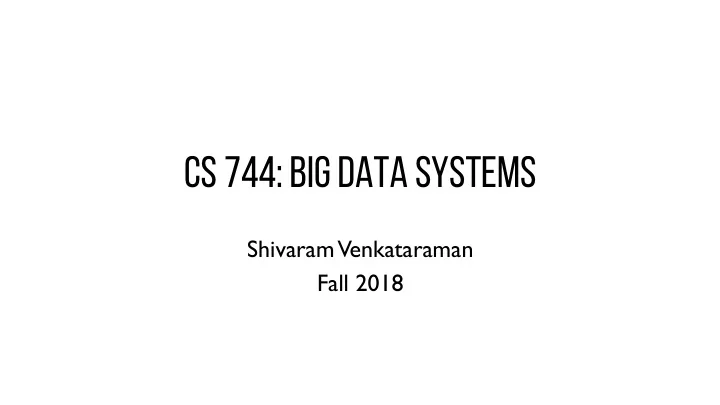

CS 744: Big Data Systems Shivaram Venkataraman Fall 2018
ADMINISTRIVIA - Assignment 2, Midterm grades this week - Course Projects: round 2 meetings next Friday - Next Tuesday: Guest speaker for first part
WHAT WE KNOW SO FAR
CONTINUOUS OPERATOR MODEL Long-lived operators Mutable State Distributed Checkpoints High overhead for Fault Recover Stragglers ? Driver Control Message Naiad Network Transfer Task
GOALS 1. Scalability to hundreds of nodes 2. Minimal cost beyond base processing (no replication) 3. Second-scale latency 4. Second-scale recovery from faults and stragglers
DISCRETIZED STREAMS
DISCRETIZED STREAMS (DSTREAMS) Approach - Use short, stateless, deterministic tasks - Store state across tasks as in-memory RDDs - Fine-grained tasks à Parallel recovery / speculation Model - Chunk inputs into a number of micro-batches - Processed via parallel operations (i.e., map, reduce, groupBy etc.) - Save intermediate state as RDD / write output to external systems
COMPUTATION MODEL: MICRO-BATCHES Micro-Batch S H U F F L E Driver Control Message Network Transfer Task
EXAMPLE pageViews = readStream(http://..., "1s") ones = pageViews.map( event =>(event.url, 1)) counts = ones.runningReduce( (a, b) => a + b)
ARCHITECHTURE
DSTREAM API Output operations save output to external database / filesystem Transformations Stateless: map, reduce, groupBy, join Stateful: window(“5s”) à RDDs with data in [0,5), [1,6), [2,7) reduceByWindow(“5s”, (a, b) => a + b) à incremental aggregation
ASSOCIATIVE, INVERTIBLE Add Subtract previous 5 previous each time and add current
OTHER ASPECTS Tracking State: streams of (Key, Event) à (Key, State) events.track( - Initialize: Create a State from the first event (key, ev) => 1, (key, st, ev) => - Update: Return new State given, old state and event ev == Exit ? - Timeout for dropping old states. null : 1, "30s”) Unifying batch and stream - Join DStream with static RDD - Attach console and query existing RDDs - Shared codebase, functions etc.
SYSTEM IMPLEMENTATION
OPTIMIZATIONS Network Communication Rewrote Spark’s data plane to use asynchronous I/O Timestep Pipelining No barrier across timesteps unless needed Tasks from the next timestep scheduled before current finishes Checkpointing Async I/O, as RDDs are immutable Forget lineage after checkpoint
FAULT TOLERANCE: PARALLEL RECOVERY Worker failure - Need to recompute state RDDs stored on worker - Re-execute tasks running on the worker Strategy - Run all independent recovery tasks in parallel - Parallelism from partitions in timestep and across timesteps
EXAMPLE pageViews = readStream(http://..., "1s") ones = pageViews.map( event =>(event.url, 1)) counts = ones.runningReduce( (a, b) => a + b)
FAULT TOLERANCE Straggler Mitigation Use speculative execution Task runs more than 1.4x longer than median task à straggler Master Recovery - At each timestep, write out graph of DStreams and Scala function objects - Workers connect to a new master and report their RDD partitions - Note: No problem if a given RDD is computed twice (determinism).
DISCUSSION/SHORTCOMINGS Expressiveness - Current API requires users to “think” in micro-batches Setting batch interval - Manual tuning. Higher batch à better throughput but worse latency Memory usage - LRU cache stores state RDDs in memory
SUMMARY Micro-batches: New approach to stream processing Higher latency for fault tolerance, straggler mitigation Unifying batch, streaming analytics
Recommend
More recommend